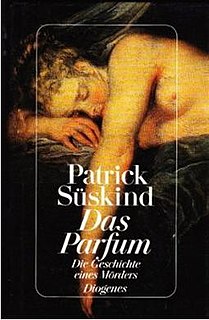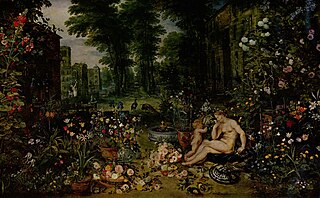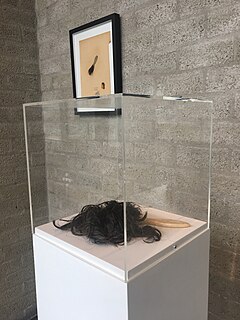Related Research Articles

The night monkeys, also known as the owl monkeys or douroucoulis, are the members of the genus Aotus of New World monkeys. The only nocturnal monkeys, they are native to Panama and much of tropical South America. Night monkeys constitute one of the few monkey species that are affected by the often deadly human malaria protozoan Plasmodium falciparum, making them useful as non-human primate experimental subjects in malaria research.

Anosmia, also known as smell blindness, is the loss of the ability to detect one or more smells. Anosmia may be temporary or permanent. It differs from hyposmia which is a decreased sensitivity to some or all smells.

Perfume is a mixture of fragrant essential oils or aroma compounds, fixatives and solvents, used to give the human body, animals, food, objects, and living-spaces an agreeable scent. It is usually in liquid form and used to give a pleasant scent to a person's body. Ancient texts and archaeological excavations show the use of perfumes in some of the earliest human civilizations. Modern perfumery began in the late 19th century with the commercial synthesis of aroma compounds such as vanillin or coumarin, which allowed for the composition of perfumes with smells previously unattainable solely from natural aromatics alone.

The vomeronasal organ (VNO), or Jacobson's organ, is the paired auxiliary olfactory (smell) sense organ located in the soft tissue of the nasal septum, in the nasal cavity just above the roof of the mouth. The name is derived from the fact that it lies adjacent to the unpaired vomer bone in the nasal septum. It is present and functional in all snakes and lizards, and in many mammals, including cats, dogs, horses, cattle, pigs, and some primates; in humans it is present, but is vestigial and non-functional.

Perfume: The Story of a Murderer is a 1985 literary historical fantasy novel by German writer Patrick Süskind. The novel explores the sense of smell and its relationship with the emotional meanings that scents may have.
Olfactory receptors (ORs), also known as odorant receptors, are expressed in the cell membranes of olfactory receptor neurons and are responsible for the detection of odorants which give rise to the sense of smell. Activated olfactory receptors trigger nerve impulses which transmit information about odor to the brain. These receptors are members of the class A rhodopsin-like family of G protein-coupled receptors (GPCRs). The olfactory receptors form a multigene family consisting of around 800 genes in humans and 1400 genes in mice.
The docking theory of olfaction proposes that the smell of an odorant molecule is due to a range of weak non-covalent interactions between the odorant [a ligand] and its protein odorant receptor, such as electrostatic and Van der Waals interactions as well as H-bonding, dipole attraction, pi-stacking, metal ion, cation-pi interaction, and hydrophobic effects, in addition to odorant conformation. While this type of recognition has previously been termed the shape theory of olfaction, which primarily considers molecular shape and size, this latter model is oversimplified since two scent molecules may have similar shapes and sizes but different sets of weak intermolecular forces and therefore activate different combinations of odorant receptors. Earlier “lock and key” and "hand in glove" models of protein−ligand binding has been replaced by a more nuanced pictures which consider the distortion of flexible molecules so as to form the optimal interactions with binding partners as in molecular docking of non-olfactory G-protein coupled receptors.
Parosmia is a dysfunction with smell detection that is characterized by the inability of the brain to properly identify an odor's "natural" smell. What happens instead, is that the natural odor is transcribed into what is most often described as an unpleasant aroma, typically a "'burned,' 'rotting,' 'fecal,' or 'chemical' smell". The term is from the Greek παρά pará and ὀσμή osmḗ. There are rare instances, however, of pleasant odors; this is more specifically called euosmia (Greek).
Luca Turin is a biophysicist and writer with a long-standing interest in bioelectronics, the sense of smell, perfumery, and the fragrance industry.
Olfactory fatigue, also known as odor fatigue, olfactory adaptation, and noseblindness, is the temporary, normal inability to distinguish a particular odor after a prolonged exposure to that airborne compound. For example, when entering a restaurant initially the odor of food is often perceived as being very strong, but after time the awareness of the odor normally fades to the point where the smell is not perceptible or is much weaker. After leaving the area of high odor, the sensitivity is restored with time. Anosmia is the permanent loss of the sense of smell, and is different from olfactory fatigue.

Estratetraenol, also known as estra-1,3,5(10),16-tetraen-3-ol, is an endogenous steroid found in women that has been described as having pheromone-like activities in primates, including humans. Estratetraenol is synthesized from androstadienone by aromatase likely in the ovaries, and is related to the estrogen sex hormones, yet has no known estrogenic effects. It was first identified from the urine of pregnant women.

Rachel Sarah Herz is a Canadian and American psychologist and cognitive neuroscientist, recognized for her research on the psychology of smell.

The evolution of color vision in primates is unique compared to most eutherian mammals. A remote vertebrate ancestor of primates possessed tetrachromacy, but nocturnal, warm-blooded, mammalian ancestors lost two of four cones in the retina at the time of dinosaurs. Most teleost fish, reptiles and birds are therefore tetrachromatic while most mammals are strictly dichromats, the exceptions being some primates and marsupials, who are trichromats, and many marine mammals, who are monochromats.

An odor, or odour, is caused by one or more volatilized chemical compounds that are generally found in low concentrations that humans and animals can perceive by their sense of smell. An odor is also called a "smell" or a "scent", which can refer to either a pleasant or an unpleasant odor.

Olfaction is a chemoreception that forms the sense of smell. Olfaction has many purposes, such as the detection of hazards, pheromones, and food. It integrates with other senses to form the sense of flavor.
Olfactory memory refers to the recollection of odors. Studies have found various characteristics of common memories of odor memory including persistence and high resistance to interference. Explicit memory is typically the form focused on in the studies of olfactory memory, though implicit forms of memory certainly supply distinct contributions to the understanding of odors and memories of them. Research has demonstrated that the changes to the olfactory bulb and main olfactory system following birth are extremely important and influential for maternal behavior. Mammalian olfactory cues play an important role in the coordination of the mother infant bond, and the following normal development of the offspring. Maternal breast odors are individually distinctive, and provide a basis for recognition of the mother by her offspring.
Odour is sensory stimulation of the olfactory membrane of the nose by a group of molecules. Certain body odours are connected to human sexual attraction. Humans can make use of body odour subconsciously to identify whether a potential mate will pass on favourable traits to their offspring. Body odour may provide significant cues about the genetic quality, health and reproductive success of a potential mate. Body odour affects sexual attraction in a number of ways including through human biology, the menstrual cycle and fluctuating asymmetry. The olfactory membrane plays a role in smelling and subconsciously assessing another human's pheromones. It also affects the sexual attraction of insects and mammals. The major histocompatibility complex genes are important for the immune system, and appear to play a role in sexual attraction via body odour. Studies have shown that body odor is strongly connected with heterosexual females. The women in the study ranked body odor as more important for attraction than “looks”. Humans may not simply depend on visual and verbal senses to be attracted to a possible partner/mate.
The University of Pennsylvania Smell Identification Test (UPSIT) is a test that is commercially available for smell identification to test the function of an individual's olfactory system. It has been administered to about 500,000 patients to this date. It is the gold standard of smell identification tests for its reliability (r=.94) and practicality. Richard Doty invented UPSIT which has been used as a self-examination test in the diagnosis of many diseases including Parkinson's disease and Alzheimer's. The test has been altered in several ways to be useful in different languages and cultures. There are also several trends that are found when UPSIT is administered based on demographics such as age, gender, history of smoking and other characteristics.
Odor molecules are detected by the olfactory receptors in the olfactory epithelium of the nasal cavity. Each receptor type is expressed within a subset of neurons, from which they directly connect to the olfactory bulb in the brain. Olfaction is essential for survival in most vertebrates; however, the degree to which an animal depends on smell is highly varied. Great variation exists in the number of OR genes among vertebrate species, as shown through bioinformatic analyses. This diversity exists by virtue of the wide-ranging environments that they inhabit. For instance, dolphins that are secondarily adapted to an aquatic niche possess a considerably smaller subset of genes than most mammals. OR gene repertoires have also evolved in relation to other senses, as higher primates with well-developed vision systems tend to have a smaller number of OR genes. As such, investigating the evolutionary changes of OR genes can provide useful information on how genomes respond to environmental changes. Differences in smell sensitivity are also dependent on the anatomy of the olfactory apparatus, such as the size of the olfactory bulb and epithelium.

Olfactory art is an art form that uses scents as a medium. Olfactory art includes perfume as well as other applications of scent.
References
- ↑ Trevino, Miguel Trancozo (12 January 2020). "The people trying to save scents from extinction". BBC .
- ↑ Bembibre, Cecilia; Strlič, Matija (7 April 2017). "Smell of heritage: a framework for the identification, analysis and archival of historic odours". Heritage Science. 5 (1). doi:10.1186/s40494-016-0114-1.
- ↑ Wapner, Jessica (1 May 2017). "George Washington stank here: Emerging science charts our olfactory heritage". Newsweek.
- ↑ Tosic, Jovana (2016). "Perfumed historic buildings: Issues of authenticity". Spatium (36): 92–99. doi:10.2298/SPAT1636092T.
- ↑ Preuschoft, Signe; Preuschoft, Holger. "Primate nonverbal communication; Our communicative heritage". In Nöth, Winfried (ed.). Origins of semiosis : sign evolution in nature and culture. Mouton de Gruyter. ISBN 978-3110141962.
- ↑ Chen, Anna (June 2016). "Perfume and Vinegar: Olfactory Knowledge, Remembrance, and Recordkeeping". The American Archivist. 79 (1): 103–120. doi:10.17723/0360-9081.79.1.103.
- ↑ Boswell, Rosabelle (July 2008). "Scents of identity: Fragrance as heritage in Zanzibar". Journal of Contemporary African Studies. 26 (3): 295–311. doi:10.1080/02589000802332507.
- ↑ Boswell, Rosabelle (18 July 2013). "Challenges to Sustaining Intangible Cultural Heritage". Heritage & Society. 4 (1): 119–124. doi:10.1179/hso.2011.4.1.119.